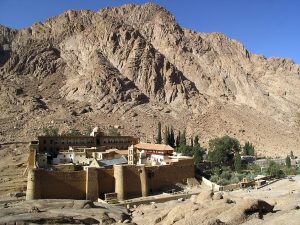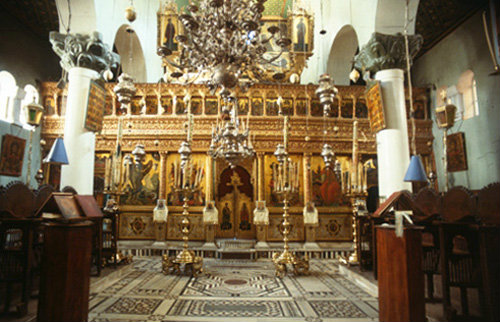For God alone my soul waits in silence, for my hope is from him. [Psalm 62:5, NRSV]
[L] St. Catherine’s Monastery in Sinai Peninsula, Egypt. [M] The oldest known icon of Christ Pantocrator. [R] Interior view of church at St Catherine’s.
Writing on ‘Jacob’s ladder’ in the previous post reminded us of St Catherine’s Monastery located at the foot of Mount Sinai in Egypt. Built between 548 and 565 A.D., it is one of the oldest working Christian monasteries in the world. The first building on the site was commissioned by St Helen, the mother of Roman Emperor Constantine, in 330 A.D., upon requests from the monks. The oldest continuously occupied and existing monastic community in the world, St Catherine’s houses some very old icons, including the oldest known icon of Christ Pantocrator. This venerable institution has survived desert storms, drought, civil war, famine, flood, the Islamic conquest, the Crusades, conquest of the Ottomans, two world wars and most recently, the Arab Spring. An Orthodox monastery, it is listed as a UNESCO World Heritage Site and is a revered place to Christians and Muslims alike.
Following from the last post, the link that draws our reflections to this monastery is of course Saint John Climacus, also known as St John of the Ladder. He became an abbot of St Catherine’s monastery in the 7th century and wrote, amongst other works, The Ladder of Divine Ascent. St. John is so highly regarded in the East that two days of the Eastern Orthodox Church year are dedicated to him. Written at the request of the Abbot of the monastery at Raithu some time in the late sixth century or early seventh century, his book enjoys such high esteem that it is still read during meals in the monasteries of the Church every year during lent.
While originally written to aid those pursuing the monastic life, this great monastic treatise yields many lessons that apply to all struggling to live faithful Christian lives outside of the monastic walls. For the spirituality of the lay people, “desert” and “monasteries” are not places in their daily lives, but an attitude, a desire to stay connected with God, the source of life and spirituality. And so, of the thirty steps that make up St John’s Ladder of the Spirit, today’s readers who seriously desire to meditate on them can easily glean a list of topics for their own silent contemplation. The following three selected and modified entries are common to the lists of all truly spiritual people.
[1] Be still and silent
 Silence “is so lacking in this world which is often too noisy, which is not favourable to recollection and listening to the voice of God,” Pope Benedict XVI said. He urged us to “cultivate interior recollection so as to receive and keep Jesus in our lives”.
Silence “is so lacking in this world which is often too noisy, which is not favourable to recollection and listening to the voice of God,” Pope Benedict XVI said. He urged us to “cultivate interior recollection so as to receive and keep Jesus in our lives”.
Our noisy life demands increasing levels of stimulations to fill our boredom. The more we are conscious of the clamours of the world around us, the more we experience an inner call to silence as an alternative consciousness.
Remaining conscious of what one is doing, one inevitably concludes that the two correctives of all spirituality are silence and service. When either of these is missing, our spirituality spirals into un-truth and dis-ease.
Silence is such a strange thing. Without it, we do not seem to experience our experiences. On the one hand, without silence, nothing has the power to lift or awaken us, or to give us that “joy that the world cannot give” (John 16:22), however much we may try to “serve”. On the other hand, without clear, free and serious acts of service that springs from the heart, no spirituality could lead to restful authenticity that has no fear of being called into question, even by one’s own conscience. Where there is a deep interior tranquility, a new way of seeing the world begins to unfold.
So we come to comprehend that “the opposite of contemplation is not action, but reaction.” The spiritual giants of the Church teach that to execute pure action, we need to engage in contemplative silence, so we may listen anew to truth and to what is really happening. From spiritual silence, one begins to meet the demands of a deep presence to oneself in the moment, to attempt to be present to God, and to attend to the silent-presence of God.
Captured by silence, we hear, which we otherwise could not. In silence, we see, which we otherwise would not. With silence, there is new “knowing” which is not thinking, and certainly beyond mental analysis. True silence relativises our ordinarily aggressive mental activities, limiting such compulsive brain-driven patterns, and compelling us to finally surrender ourselves to the primal being and identity that we have in God. Silence requires no stimulation, but bans it. God is only found at the depths of things, including the depths of our sin and brokenness. And in the depths, it is always silent. Silence is where we must go when we want to be truly spiritual, to stay connected with God, to let God speak to the heart. Mystics find God in the depth of their silence. In monasteries, silence is golden.
[2] Pray ceaselessly, staying constantly connected with God
To pray ceaselessly is to stay constantly connected with God.
If we pray without ceasing, we shall not be in want of things before we can give thanks. Rather, we shall have cause to give thanks for apparent lack as well as in plenitude, for successes as well as for afflictions. We rejoice more if we pray more. In constant prayers, we learn not to quench the Spirit. So St Paul urged his young converts in Thessalonica to never stop praying:
- Rejoice always, pray constantly, give thanks in all circumstances; for this is the will of God in Jesus Christ for you [1 Thess 5:16-18].
Jesus stayed connected with his Abba Father throughout his three-year public ministry. Jesus stayed connected with his Abba Father throughout his three-year public ministry. He remained in intimate spiritual communion with God till he breathed his last at Calvary. Jesus in his humanity is given a name, that is, he becomes specified in his relationship with God as Emmanuel – God with us.
Prayer helps move forward all lawful business, and every good work. A contemplative monk tells a busy businessman who seeks God to stay connected with God by saying a prayer every five minutes. A university dental student who is a member of Opus Dei says silent prayers for people she sees at a bus stop while she waits for her bus. Imagine the reality of God in their lives and the presence of God in their decisions and actions throughout their twenty-four hour day.
In many an adventure in life, Christian men and women have learned that in staying connected with God, good things do not lose their goodness even in the worst of times. But, disconnected from God, even good things can turn bad in the best of times.
[3] Live in simplicity and detachment
Practicing spiritual detachment does not mean we are not to own things at all. What spiritual detachment does is to lead us away from things of the world, forsaking possessions and resisting greed, behaving like an exile, a pilgrim, or a “resident alien”. We shall not turn worldly possessions into golden calves.
- Do not love the world or the things in the world. The love of the Father is not in those who love the world; for all that is in the world – the desire of the flesh, the desire of the eyes, the pride in riches – comes not from the Father but from the world. And the world and its desire are passing away, but those who do the will of God live forever [1 John 2:15-17, NRSV].
Detachment presupposes a willingness to live in simplicity. In his book titled “Simplicity,” Richard Rohr points out the fallacy in the western assumption that we live according to our rationality. It is in fact the other way round. In his simple ways, Pope Francis cracks that western assumption and shows us all that it is the way we live, that we get into a new way of life. “We live our way into a new life of thinking.”
So crucial is spiritual detachment to discipleship that Jesus taught that whoever puts his hand to the plow, but then looks back is not fit for the kingdom of heaven [Luke 9: 62]. In his talk to the Brazilian bishops in July 2013, Pope Francis exhorted all bishops to be men who love poverty, both interiorly and exteriorly. Interior poverty is essential because it leads to freedom before the Lord, while exterior poverty is indispensable for a church leader whose authentic lifestyle can only be seen in simplicity and austerity. So concerning the race of spiritual ascent, St. John of the Ladder exhorts us to imitate Lot, not Lot’s wife. Look straight on; do not look back. Follow the angel leading you to salvation. Do not turn back to gaze at what you have left behind.
Copyright © Dr. Jeffrey & Angie Goh, May 2015. All rights reserved.
You are most welcome to respond to this post. Email your comments to jeffangiegoh@gmail.com. You can also be dialogue partners in this Ephphatha Coffee-Corner Ministry by sending us questions for discussion.



